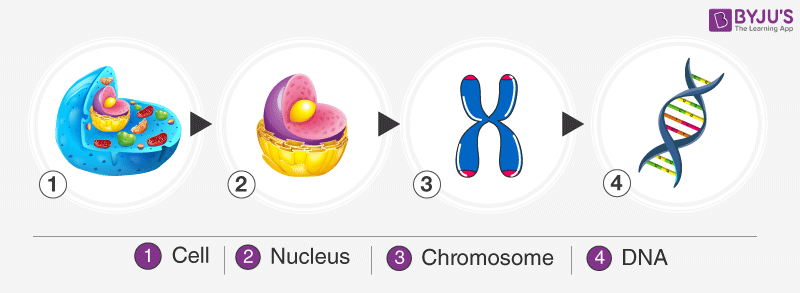The DNA structure was proposed by Watson and Crick. According to them, the DNA is a double-helical structure with two polynucleotide strands running anti-parallel to each other. This double helix is negatively charged due to the presence of phosphate groups in the DNA backbone. The cell makes histone proteins that bind the DNA to counterbalance the negative charge. These histone proteins are involved in DNA packaging.
Read on to explore what is DNA packaging and why it is required.
Table of Contents
DNA Packaging Definition
“DNA packaging is the process of tightly packing up the DNA molecule to fit into the nucleus of a cell.”

DNA Packaging
What is DNA Packaging?
Have you ever wondered how DNA is present in a nucleus smaller than it? This can be explained by the process of DNA packaging.
DNA is an organic, complex, molecular structure found in both prokaryotic and eukaryotic cells and also in many viruses. It is a hereditary material which is found in the nucleus of the cell and is mainly involved in carrying genetic information.
The DNA structure has the following characteristics:
- The strands of the DNA are helically wounded, every single strand forms a right-handed coil.
- The pitch of each helix is 3.32 nm, and about 10 nucleotides make up one turn.
- The distance between two succeeding base pairs is 0.34 nm
- The total length of a DNA is the distance between two succeeding base pairs and the product of a total number of base pairs.
- A typical DNA strand has a length of approximately 2.2 meters, which is much longer than a nucleus.
Prokaryotic cells can be distinguished from eukaryotic cells by the absence of a well-defined nucleus. However, their negatively charged DNA is arranged in a region called the nucleoid. They appear as a loop wrapped around a protein molecule having a positive charge.
All eukaryotes have a well-defined nucleus that contains DNA. DNA is a negatively charged polymer, packed compactly within the chromatin, engirdling the histone proteins, a ball of positively charged proteins.
The octamer of histone proteins is wrapped with a DNA helix, giving rise to a structure called nucleosomes. The nucleosomes are further coiled, which results in the formation of chromatin fibres. Chromatin fibres are stained thread-like structures, whereas nucleosomes are beads present over them. These chromatin fibres condense to form chromosomes during mitosis.
Also Read: Difference between Prokaryotic and Eukaryotic Cells
Histones
Histones are the proteins promoting the DNA packaging into chromatin fibres. Histone proteins are positively charged, possessing several arginine and lysine amino acids binding to the negatively charged DNA. There are two types of Histones:
- Core Histones
- Linker Histones
H2A, H2B, H3 and H4 are the core histones. Two H3 and H4 dimers and two H2A and H2B dimers form an octamer.
Linker histones lock the DNA in place onto the nucleosome and can be removed for transcription.
Histones can be modified to change the amount of packaging a DNA does. The addition of the methyl group increases the hydrophobicity of histones. This results in tight DNA packaging.
Acetylation and phosphorylation make the DNA more negatively charged and loosens the DNA packaging.
Enzymes that add methyl groups to histones are called histone methyltransferases. The enzymes that add acetyl groups to the histones are called histone acetyltransferase, while the ones that remove the histones are called histone deacetylases.
Also Read: Molecular Basis of Inheritance
Why is DNA packaging required?
The length of the DNA is around 3 meters which needs to be accommodated within the nucleus, which is only a few micrometres in diameter. In order to fit the DNA molecules into the nucleus, it needs to be packed into an extremely compressed and compact structure called chromatin.
During the initial stages of DNA packaging, the DNA is reduced to an 11 nm fibre that denotes approximately 5-6 folds of compaction. This is achieved through a nucleosome order of packaging.
There are three orders of DNA packaging
- The first order of DNA packaging – Nucleosome.
- The second order of DNA packaging – Solenoid fibre.
- The third order of DNA packaging – Scaffold loop Chromatids Chromosome.
Also Read: DNA Replication
One of the benefits of DNA packaging is that it can be separated into things we use a lot and the things we don’t use at all. There are certain parts of DNA that are required only at certain times. Regions that are essential for the synthesis of proteins are loosely packed and are known as euchromatin. This helps the DNA to easily get in and make RNA. The heterochromatin has tightly packed DNA, which is rarely required.
Also Read: DNA structure
Discover more about DNA packaging and the process of DNA packaging only at BYJU’S Biology
Frequently Asked Questions
What do you understand by DNA packaging?
DNA packaging is the folding of an organism’s DNA into a compact structure that can fit within the nucleus of a cell.
How is DNA packaged in a cell?
The cells wrap their DNA around scaffolding proteins to form a condensed structure called chromatin. The chromatin is further folded to form different structures that eventually form chromosomes.
What is the importance of DNA packaging?
DNA packaging is important because the DNA is very long. In order to fit the DNA into the nucleus, it needs to be packaged properly.
What role do histones play in DNA packaging?
Histones are proteins responsible for DNA packaging. The DNA wraps around the histones. Histones are positively charged proteins and hence can easily bind to negatively charged DNA. Histones are also involved in controlling the expression of genes.
How do acetylation and phosphorylation affect DNA packaging?
Acetylation and phosphorylation make the DNA more negatively charged and loosens the packaging of DNA. The enzymes that add acetyl groups to histones are called acetyltransferases.


THANK YOU SO MUCH FOR THESE EXTRA INFORMATION IN A VERY DETAILED MANNER
Best answer, helpful